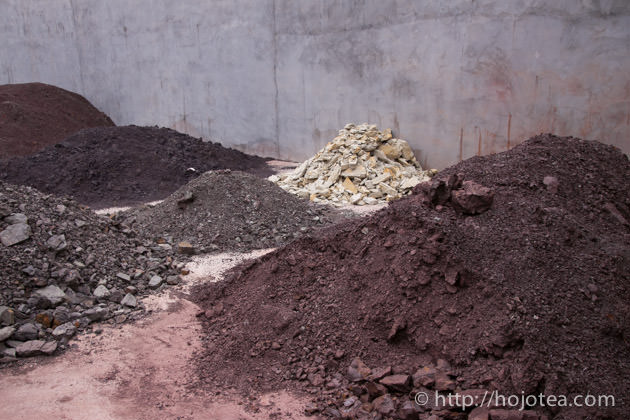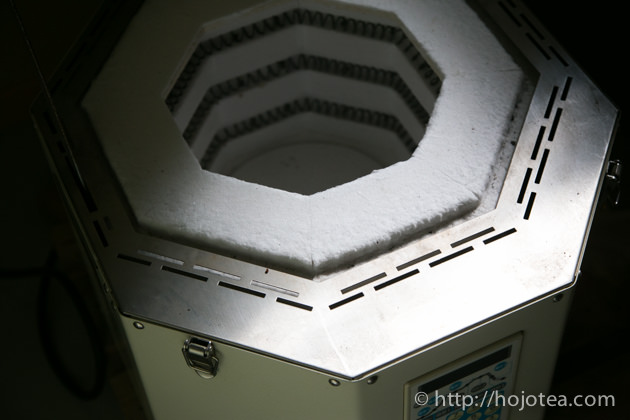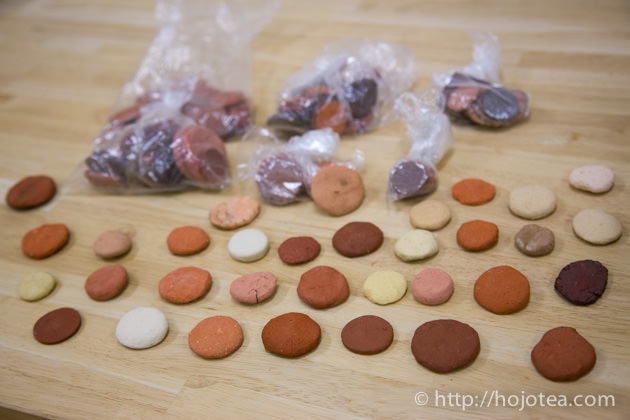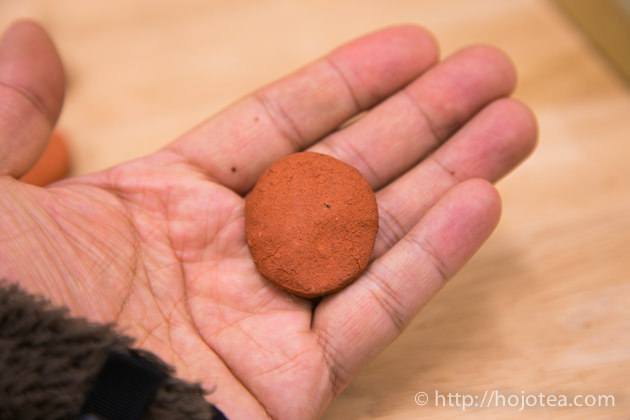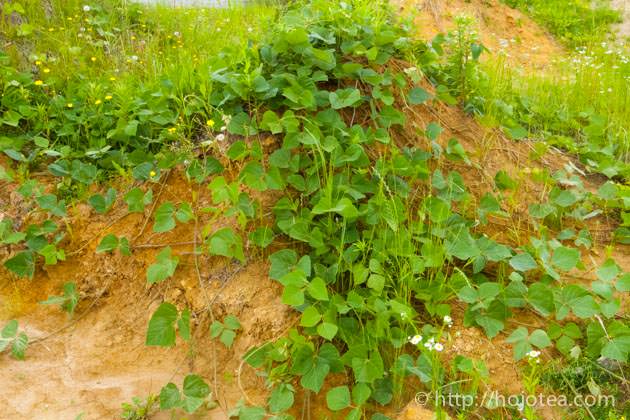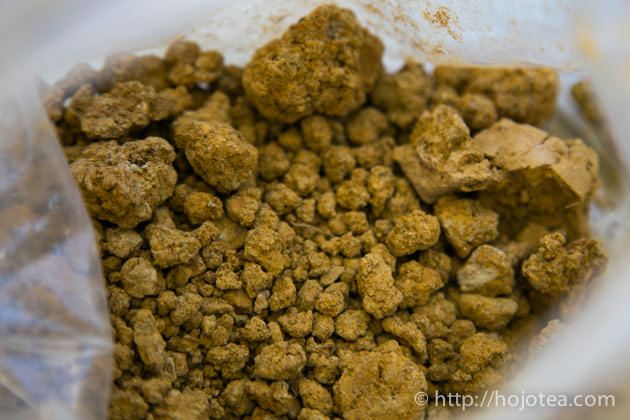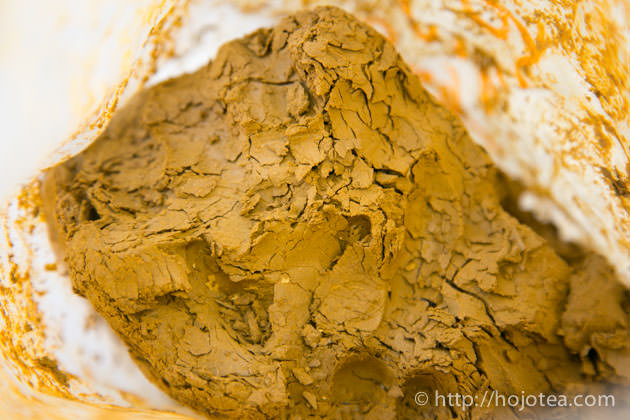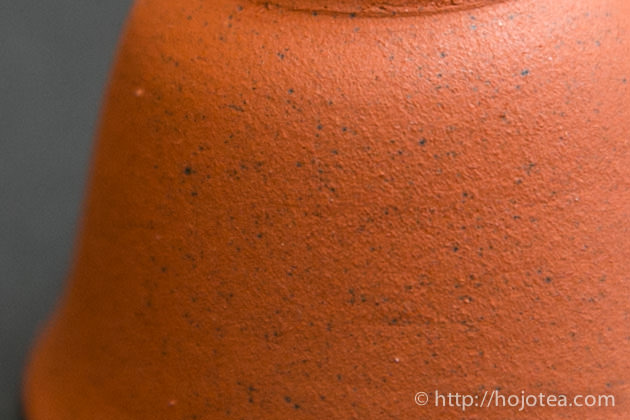- HOME >
- Featured Articles
Iga Natural Red Clay from the Hometown of Ninja
- [2015.03.18] Posted By Akira Hojo
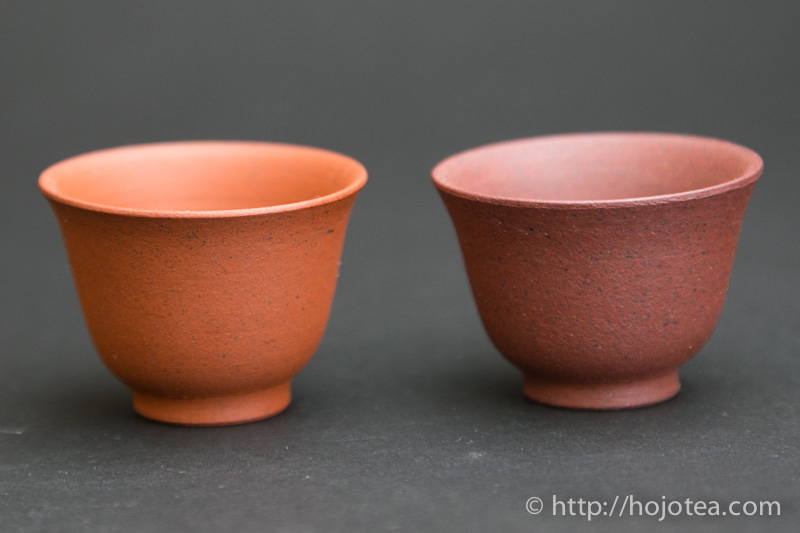
I discovered very interesting clay in Iga, a place known as the hometown of Ninja in Japan. We are preparing to produce teapots using this special clay.
Taste of tea differs a lot depending on the clay
The clay used for making teapot influences the taste and flavour of tea. It sometimes enhances the depth of taste and increase the aftertaste or sometimes it increases the body, the width of taste and enhances the boldness of the taste. However, not all clay works on the positive side. If we choose the wrong type of clay, it diminishes the body and aftertaste of tea. It is all depending on the clay whether it makes tea tastes bolder or flatter.
The old Yi Xing teapot and the contemporary Yi Xing teapot
In China, people paid attention to the relationship between clay and the taste of tea since a few hundred years ago. In particular, the fame of Yi Xing teapot has been recognized not only in China but by many people around the world. I believe it is not because of the potter in Yi Xing who has special ability to taste tea. They are not an expert in tasting tea but an expert in making teapot out of clay. It was thanks to the support by the people who were well aware of the taste and understand the tea culture very well. Thanks to the effort and passion of these people who keep looking for the better material in terms of the taste alteration, they have eventually discovered some great clay and it was well recognized. It was thanks to the location advantage of Yi Xing too. Yi Xing is located in Jiangsu province where culturally and economically very rich place it is. There were many tea lovers who were wealthy enough to support these teapot makers in Yi Xing. In fact, while I was travelling in many places in China, I have noticed that there were many other places where the abundance quantity of good clay is found. For example, most of the famous tea production areas do have good clay. I always admire the clay in Wu Dong Shan in Phoenix town, many places in Yunnan and Junshan Island. However, these places cannot be the second Yi Xing unless there are people who could understand and tell the relationship between clay and taste. It will end up nothing but just red clay otherwise.
However, the situation in Yi Xing has changed a lot recently. Due to the over-popularity and fame, customers are willing to pay as long as the teapot is made in Yi Xing or made by the famous artists. Most buyers lost the mean to understand the performance of the clay. Consequently, the artists pay more attention for the name of clay or the appearance of teapot. Nowadays, quite a number of teapots in Yi Xing are made of the blended clay. It becomes very challenging to find a fine teapot that performs as great as the old Zhuni (朱泥) teapot.
Historically, the appearance of tea ware was much emphasized in Japan
As for Japan, traditionally, partly due to the influence by Rikyu (千利休), market was much more interested in the appearance of tea ware known as Wabi-sabi than the effect to the taste. As the result, the artist in Japan paid more attention and worked hard to look for the material that gives special effect in wabi-sabi appearance. Of course the most of Japanese might have ever heard that clay pot or clay teapot makes tea taste smoother. But the understanding is quite shallow and vague. Very less Japanese people are aware that different material gives different effect.
The value of teapot or the fame of the artist does not reflect in the quality of the clay
Some people look for the teapot made by the famous artist or expensive teapot hoping that the clay performs better. However, the fame or price has nothing to do with the performance of clay, unless the clay is selected based on the effect to the taste of tea. The teapot artist is not the expert in taste but pottery. It is essential to have collaboration between potter and tea professional.
Searching for the original clay
I learned from the experience that I must look for the clay by myself instead of looking for the artist if I want to introduce the teapot that clay performs excellently. For selecting clay, it is important to ensure that the clay is solid enough and not to absorb water after the firing. There are many aspects that we have to review in order to select the right clay out of vast number of natural clays.
To conduct the screening of clay, I produce small clay test piece in the shape like cookies, and fire it with a small kiln in my company. And then I steep each test piece in tea to evaluate its effect on flavour and taste. The tasting is carried out according to the criteria such as body, after taste and astringency. After several rounds of screening, I narrow down the clay into a few types, I need to further study the relationship between the fineness of clay and taste, and the firing temperature and taste.
Clay that enhances the body
I wanted to find the clay that enhances the body. It may not be easy to understand what body means. In a simple way, I wanted to find the clay that widens the taste of tea on palate and blooming the flavor like a flower. The clay that enhances the body is suitable for fermented teas, such as oolong, black tea and raw pu-erh. It also works well for green tea. The flavour of green tea becomes very rich if this clay is used. With stronger body, you may feel the sweetness around the palate at the side of mouth and it lingers for a while. Based on my experience, it is less difficult to find the clay teapot that increases the after taste. Some metal ware such as iron kettle, tin and silver will increases the aftertaste too. However, it is quite hard to find the clay that enhances body. That is the reason I wanted to look for the clay that increases body. I assumed that the clay in either Shigaraki or Iga area may increases body. It is because the sake, tea and water in these areas give very strong body. The Iga and Shigaraki used to be the bottom of the Biwa Lake back in a few hundred million years ago. The soil in these places is very rich in alkaline minerals and it enhances the body when it is used for the teapot or other tea ware. Generally, Iga and Shigaraki is known for the white clay. However, these places also produce very special red clay (朱泥) too.
There are many red clays that do not perform
Many people believe that any kind of red clay (朱泥) works well for tea. In fact, there is very limited type of red clay that gives positive effect in taste. The natural clay contains various impurities. These impurities somehow affect the taste and often give negative effect. Based on my experience, it is very lucky if we could find one type of reasonably good clay out of ten types of clay. Even in the same area, the characteristics of clay are not the same depending on the location, the layer and the way how it is collected and refined. The most challenging part is to find the clay that gives no or least astringency. Many types of clay I found gives quite good effect in terms of the after taste and body, but the astringency is very obvious too. It is very intensive work to find out the right clay out of various types of natural clays.
Iga red clay from the hometown of Ninja
So far I have tested more than 100 types of natural clay. As a result, the red clay collected from the Iga 伊賀 shows an outstanding result. It is collected from the thin layer about 10-20cm right below the compost on the surface of the mountain. The crude clay gives very thick yellow colour. The clay requires further refining since it contains a lot of coarse sands. After the refining process, the fine clay is made into test piece. The result is very outstanding; it drastically enhances the body. The flavour of tea widely spread and an intense sweetness lingers on the palate. In particular, it works excellently for oolong and black tea.
For the next stage of experiment, I have planned a few different refining methods. After preparing the test pieces, I will finalize the optimum refining method as well.
We only managed to collect very limited quantity of clay
Due to the limited availability, I only managed to secure about 1 to 2 m3 of crude clay. It will be further refined and get it ready for pottery. I will purchase the clay, arrange refining by outsourcing and supply the necessary weight of clay for the artist to make tea ware.
Trial run using the actual kiln
Since I have finalized the clay, I moved on to the next stage of the experiment. It was very important for me to produce either tea cup or teapot and fire it in the kiln that is used for the actual firing. The small kiln I owned is meant for amateur potter. The firing condition is different compared to commercial kiln in big scale. The professional model can accommodate many teapots at one time. The teapots in the kiln somehow keep the temperature high and it takes longer time to cool down. For example, if I set the temperature of big scale kiln at 1150 degree C, it maintains this temperature for a while and very slowly it reduces. As for the small kiln, as soon as the temperature reaches at 1150 degree C, soon the temperature drops quickly. It is the same theory as the hot water in larger container takes longer time to cool down.
Optimization of the firing temperature
The first experiment using the professional kiln was planned last year in November. We set temperature at 1180 degree C based on the data with my small kiln. However, the colour of tea cup becomes maroon, indicates the firing temperature was obviously too high. The firing temperature affects the porosity on the surface of clay. The higher the firing temperature, the less porous it becomes, and it gives less effect in taste. So we decided to conduct another round of experiment in December last year. We drastically reduced the firing temperature. As a result, the colour of tea cup becomes brighter and more orange colour. The clay was solid enough that there is no water leakage. The surface of this clay is a little rough. But it is nice characteristic for me as it may grow more after seasoning with tea.
The new clay may be available in next May or June
The taste was better than that of my earlier experiment. It noticeably enhances the body as well as after taste. I tried Taiwanese oolong in this new clay cup. It is really impressive. When I pour Ali Shan oolong in this cup, it tastes like Cui Feng. Now we are preparing to refine the crude clay. Since it takes some time to get ready for the clay, the first batch of Iga red clay teapot may ready in next May or June.
Related Articles
How to get the latest update on HOJO?
1. Follow Twitter, 2. Click "Like" on Facebook, and 3. Subscribe in newsletter. You can have the latest tea news from HOJO.
 Subscribe the Newsletter to enjoy the privileges
Subscribe the Newsletter to enjoy the privileges- You may receive a free sample upon purchase, or you may have the priority to purchase special products. So please remember to subscribe our newsletter as well as the social network.
- Myanmar White Tea Bud 2013 from Guo Gan, Myanmar
- We have released a raw Pu-erh tea, 緬甸白芽茶 2013 (Myanmar White Tea Bud 2013), produced by ethnic minorities in t …
- Yong De Wild White Tea 2025 Loose Leaf Limited Release
- We have released Yong De Wild White Tea Loose 2025. For the 2025 harvest, only the loose-leaf type was …
NEW ARTICLES
 Myanmar White Tea Bud 2013 from Guo Gan, Myanmar
Myanmar White Tea Bud 2013 from Guo Gan, Myanmar- We have released a raw Pu-erh tea, 緬甸白芽茶 2013 (Myanmar White Tea Bud 2013), produced by ethnic minorities in t …
 Yong De Wild White Tea 2025 Loose Leaf Limited Release
Yong De Wild White Tea 2025 Loose Leaf Limited Release- We have released Yong De Wild White Tea Loose 2025. For the 2025 harvest, only the loose-leaf type was …
 Experience the True Freshness of Raw Pu-erh : Tang Jia 2025 Loose Leaf Release
Experience the True Freshness of Raw Pu-erh : Tang Jia 2025 Loose Leaf Release- We have released Tang Jia Raw Pu-erh Tea 唐家古樹生茶 2025 Loose Leaf. Among HOJO’s raw pu-erh teas, Tang Jia Raw Pu …
 Yunnan Chun Jian Green Tea from High Mountain Gardens
Yunnan Chun Jian Green Tea from High Mountain Gardens- Yunnan Chun Jian Green Tea is now available. This tea is made from naturally grown leaves harvested from high …
 Limited Loose Leaf Release of 2025 Da Xue Shan Wild Raw Pu-erh Tea
Limited Loose Leaf Release of 2025 Da Xue Shan Wild Raw Pu-erh Tea- We have released the 2025 loose-leaf version of Da Xue Shan Wild Raw Pu-erh Tea. This tea comes from wild tea …
 Discover a New Way to Enjoy Tea: Cooking Rice with Tea
Discover a New Way to Enjoy Tea: Cooking Rice with Tea- Cooking rice with tea is a simple idea, but it brings surprisingly satisfying results. The tea’s flavour seeps …
 2025 Da Xue Shan Wild White Tea Now Available from Yunnan
2025 Da Xue Shan Wild White Tea Now Available from Yunnan- The 2025 harvest of Da Xue Shan Wild White Tea is now available. Crafted from truly wild Camellia taliensis tr …
 Fresh 2025 Yunnan White Tea – Select Your Favourite Lot Before Blending
Fresh 2025 Yunnan White Tea – Select Your Favourite Lot Before Blending- Freshly crafted in Yunnan and just arrived in KL, our new 2025 white tea is now available at our Gardens Mall …
 2024 Dong Shan Raw Pu-erh Tea – Crafted with the Producer for Desired Quality
2024 Dong Shan Raw Pu-erh Tea – Crafted with the Producer for Desired Quality- We have released the 2024 cake of Dong Shan Raw Pu-erh Tea. Earlier, we offered the loose-leaf version from th …
 Development of Firewood Roasted Hojicha Using Naturally Grown Tea from Yunnan
Development of Firewood Roasted Hojicha Using Naturally Grown Tea from Yunnan- We are currently staying in Yunnan Province for tea production. As the season nears its end, tea trees with pa …
Category
- New Arrival at HOJO Online Shop
- Featured Articles
- Newsletter
- Types of Tea
- Origin of Tea
- Teapot and Tea Equipment
- Tea Column
- How to enjoy tea
- Tea Processing
- How to choose quality tea
- Tea constituents and functional effect
- Safety of Tea
- Foods
- Tea Business Operation
- Hobby and Outdoor Activity
- Ranking of Tea
- Video
- FAQ
- Media Release
Profile

- AKIRA HOJO
- I invite you to experience my tea selections.I was born in Nagano, Japan. In university, I studied agricultural chemistry, and I have the master degree in food science. I worked in Japanese food industry for 10 years. I involved in R&D, QC and QA. As a factory manager, I implemented ISO9000 series and managed the factory.
- The Art of Tea Magazine
- We posted the article on “The Art of Tea Magazine No.9, the magazine is published in Taiwan. We featured …
- New Straits Times
- The Malaysian National Newspaper, New Straits Times featured HOJO Tea on 17-Oct-2007.
Shop Info

Address:Lot No. T-215, 3rd Floor, The Gardens Mall, Mid Valley City, Lingkaran Syed Putra, 59200 Kuala Lumpur
Tel: +603-2287-4537
Business Hour: 10am to 10pm



